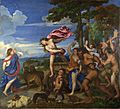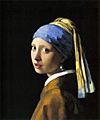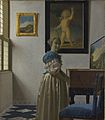Ultramarine facts for kids
| This box shows the colour Ultramarine. |
|---|
Ultramarine is a blue pigment, and the name of a blue colour. The pigment is found naturally. It is ground down from a mineral called Lazurite, the main component of lapis lazuli. The colour is due to the presence of S−3 anions (trisulfur).
Contents
Synthetic ultramarine
Synthetic ultramarine is a more vivid blue than natural ultramarine, since the particles in synthetic ultramarine are smaller and more uniform than natural ultramarine and therefore diffuse light more evenly.
Artificial, like natural, ultramarine has a magnificent blue colour. Since it is not affected by light or contact with oil or lime, it is used in painting.
A small addition of zinc-white (zinc oxide) causes the colour to become less vivid (~bright). Synthetic ultramarine, invented in the 1820s, is very cheap. It is largely used for wall painting, the printing of paperhangings and calico. It is also used to correct the yellowish tinge found in things meant to be white, such as linen, paper, etc. Bluing or "laundry blue" is a solution of synthetic ultramarine (sometimes, prussian blue) that is used for this purpose when washing white clothes. Large amounts are used in making paper, especially the kind of pale blue writing paper popular in Britain. During World War I, the RAF painted the outer roundels with a colour based on ultramarine blue. This became BS 108(381C) Aircraft Blue. It was replaced in the 1960s by a new color based on phthalocyanine blue, BS110(381C) Roundel Blue.
Comparison of green, teal, blue and ultramarine
| Name | Color | HEX Code | Red | Green | Blue | Hue | Sat | Lum |
|---|---|---|---|---|---|---|---|---|
| Green | #008000 | 0 | 128 | 0 | 120° | 100% | 50% | |
| Teal | #008080 | 0 | 128 | 128 | 180° | 100% | 50% | |
| Blue | #0000FF | 0 | 0 | 255 | 240° | 100% | 100% | |
| Ultramarine (Electric Ultramarine) | #3F00FF | 63 | 0 | 255 | 255° | 100% | 100% |
Related pages
Images for kids
-
Lapis lazuli specimen (rough), Afghanistan
-
The blue robes of the Virgin Mary by Masaccio (1426) were painted with ultramarine.
-
Pietro Perugino economized on this painting of the Virgin Mary (about 1500) by using azurite for the underpainting of the robe, then adding a layer of ultramarine on top.
-
Titian made dramatic use of ultramarine in the sky and draperies of Bacchus and Ariadne (1520–23).
-
Sassoferrato's depiction of the Blessed Virgin Mary, c. 1654. Her blue cloak is painted in ultramarine.
-
Girl with a Pearl Earring, by Johannes Vermeer (c. 1665)
-
Lady Standing at a Virginal, by Johannes Vermeer (c. 1675)
See also
 In Spanish: Azul ultramar para niños
In Spanish: Azul ultramar para niños












